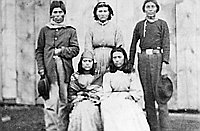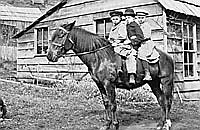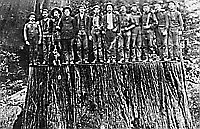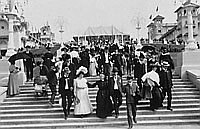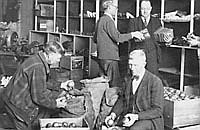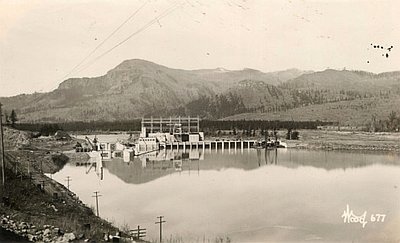Like other western states, Oregon has a sizable public land base, with approximately 53 percent of its 61 million acres in federal lands, most of it managed by the BLM and the U.S. Forest Service. Other important federal holdings include Crater Lake National Park, several national monuments, and the recently created Steens Mountain Cooperative Management area. State and local governments control another 3 percent of Oregon land.
President Theodore Roosevelt created Crater Lake National Park in 1902, the sixth national park in the nation. The park was the result of the successful efforts of William Gladstone Steel and the Portland-based climbing group, the Oregon Alpine Club (subsequently renamed the Mazamas). Steel, who first visited Crater Lake in 1885, worked tirelessly for seventeen years to gain protected status for the spectacular caldera. He also promoted interest in Oregon’s Cascade Range and its scenic splendors, including Mt. Hood and the Three Sisters.
The Forest Service is charged with managing 15.6 million acres and the BLM 15.7 million acres of Oregon’s public lands. Although the state’s most productive, low-elevation forest lands are in private ownership, national forest timber has been important to local economies. In addition to its vast rangelands in southeastern Oregon, the BLM also manages the 2.2 million acres of O&C timberlands in western Oregon.
Because of Oregon’s sizable federal lands, management decisions have always been politically volatile. Before about 1970, most controversies over the national forests involved access to remote areas, road-building, fire prevention, and—by the early 1960s—wilderness set-asides. With the emergence of the environmental movement in the 1970s, however, there was growing public criticism of clearcutting, a management practice that was especially popular in the Douglas-fir districts.
Environmental groups, congressional committees, and a few foresters began to question the ecological soundness of clearcutting. Forest industry groups responded aggressively in its defense, urging the public to “think of the forest as a crop” that should be managed for maximum productivity. Jerry Franklin, a young scientist who would become known for his progressive understanding of forest ecology, began to offer scientific challenges to clearcutting. He suggested that the biological requirements for good forestry required a variety of harvesting practices.
Oregon governors Tom McCall (1967-1975) and Robert Straub (1975-1979), both known for their environmental activism, never openly criticized clearcut harvesting. McCall’s biographer Brent Walth has concluded that the governor’s environmentalism had limits, especially when it ran counter to the state’s economic health. For his part, Straub agreed that clearcuts should be limited in size to reduce their visual impact, but he firmly supported the practice.
For the first time since logging and lumbering emerged as a powerful element in Oregon’s economy, the industry’s forestry practices were being criticized from seemingly every direction. Before court orders invoking the Endangered Species Act—the spotted-owl decrees—began to curtail national forest harvests in the late 1980s, public debate focused on the size of proposed wilderness areas and the use of chemical herbicides and insecticides on public and private forest lands. Although the application of DDT came under increasing criticism after the publication of Rachael Carson’s Silent Spring in 1962, it remained the insecticide of choice for most foresters until the federal government banned its use in 1972.
The debates involving DDT were the opening volleys in the application of chemicals in forest environments. The greatest controversy during the 1970s—and a carry-over from the Vietnam War issues—centered on the use of the herbicide 2,4,5-T, which produced highly toxic trace elements of dioxin (TCDD). The Forest Service continued to spray with 2,4,5-T in western Oregon to control brush until the federal government prohibited its use in the late 1970s.
The invocation of the Endangered Species Act to protect the spotted owl, marbled murrelet, and a number of salmon species in the 1980s and 1990s divided Oregon’s public largely along urban and rural lines. When federal agencies and the courts determined that logging, grazing, and agricultural activities were harmful to endangered species, the natural resource industries and their rural constituencies felt that they were under siege.
The U.S. Fish and Wildlife Service listing of the spotted owl as a threatened species in June 1989 triggered a series of lawsuits, sharply curtailed national-forest harvests, and brought a torrent of protests from timber-dependent communities. In many respects, the owl was a smokescreen for diminished supplies of national forest timber, automated and efficient sawmills that employed only a handful of workers, increasing competition from Canadian imports, and the emergence of a vibrant forest-products industry in the Southeast.
There were other complicating factors. When Northwest sawmills began to close in the late 1980s and early 1990s, private firms continued to export raw logs to Japanese, Korean, and Taiwanese markets. Although federal restrictions banned overseas log exports from the national forests, no regulations prohibited the sale of logs harvested on private lands. Washington and Oregon exported nearly 4 billion board feet of raw logs in 1988, approximately 25 percent of the total cut for the two states. While mills in Coos Bay and elsewhere lay idle, huge stacks of dockside logs awaited shipments to Asian markets.
The consequences for many timber-dependent communities were high unemployment, rising social problems, an eroding tax base, and an exodus of young people in search of education and employment. President Bill Clinton’s Forest Summit in Portland in 1993 and the adoption of the Northwest Forest Plan were intended to resolve the crisis and provide a balanced program that would satisfy both logging communities and environmental groups. The plan did neither: loggers and their families continued to define the problem as owls versus jobs, environmentalists persisted with their lawsuits and protests against federal timber sales, and the stalemate persisted into the twenty-first century.
© William G. Robbins, 2002. Updated and revised by OE Staff, 2014.
